The Bohemian Artist
Modigliani's romantic sensibilities and
careless disregard for his health in his intensive pursuit of his artistic
talents, led him to fulfil the tragic role of the handsome but doomed youth.
Amedeo
Clemente Modigliani was born on 12 July 1884 in the Italian Mediterranean port
of Livorno. Rumour had it that the Modigliani family were once bankers to the
popes and that his mother was descended from the great philosopher, Spinoza.
Modigliani encouraged these elaborations which, as usual, contained a degree of
truth.
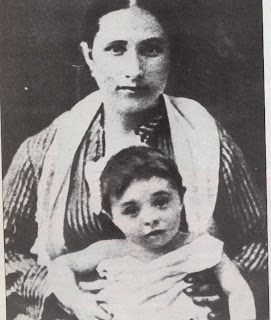
Amedeo's father, Flaminio, was a businessman
who was ruined in the year the boy was born. Flaminio's commercial failure
forced him to travel widely and Amedeo's mother, Eugenia, was left to run the
household. Both were Sephardic Jews, that is people who were originally
descended from the Jewish settlers in Spain. As part of their faith, the
Modigliani family respected their ancient traditions and valued a liberal
education. In the eyes of the Livorno bourgeoisie, Eugenia was unconventional:
she drank tea (an English practice), wrote literary articles and did
translation work. This was more practical than progressive for she kept an extended
family, and Dedo (as Amedeo was called) was the youngest.
The
young Modigliani grew up in a lively and stimulating environment, soon
developing a variety of cultural interests way beyond his years. His mother
introduced him to the Romantic and Symbolist poets like Leopardi, Wilde,
Baudelaire and Rimbaud. Through his aunt Laure, he became acquainted with the
philosophy of Nietzsche who wrote of the artist exiled from society by his
creative genius and intuitive nature. Later, during his years in Paris,
Modigliani would chant poetry to his friends - verses as elegant and
self-contained as his paintings.

Modigliani
was a spoiled and capricious child, partly because he was a beautiful-looking
little boy, and partly because of his fragile health. In the summer of 1895, he
developed pleurisy and, in 1898, he suffered a serious attack of typhoid. In
the same year, his mother wrote in her diary: 'On the first of August, Pedol
begins drawing lessons. . . He thinks he's already a painter; as for me, I
don't really want to encourage him, in case he completely neglects his studies
to pursue this shadow.' Modigliani joined the art class of Guglielmo Micheli in
1898, and soon afterwards formed a breakaway art group. But late in 1900,
tuberculosis aggravated by an attack of pleurisy was to put an end to his
studies.
FRESH SURROUNDINGS
During
a period of convalescence, Modigliani travelled to Naples, Amalfi and Capri and
later to Rome and Venice. With his health restored, he left his home town in
1902 to study first in Florence, and then in Venice, where he made many
friends-among them the painter Umberto Boccioni - and studied the work of the
old masters, Bellini, Titian and Carpaccio.
In
January 1906, Modigliani left for Paris, determined to chance his luck as a
portrait painter. Here he enthusiastically adopted a similar bohemian lifestyle
to that he had sampled in the old quarters of Venice. He used stimulants,
mostly hashish and alcohol, maybe in an attempt to overcome his characteristic
shyness. Even so, his first French patron, a young doctor called Paul
Alexandre, remembered 'a very well brought up young man', who did most things
in moderation.
After a
few weeks of luxury in a comfortable hotel, Modigliani began to lead a nomadic
existence, moving from one lodging house to another, first in Montmartre, then
south of the Seine in Montparnasse. The small allowance his mother sent was
insufficient to support a life spent increasingly in bars and brothels. Unable
to pay his bills, he gave away pictures and did hack work, making portraits in cafés
for a few francs.
Paris
made Modigliani sensitive to his Jewish origins; and he discovered spiritual
and artistic affinities with the 'peintres maudits', the 'accursed painters',
who were mostly Jewish, stateless and poor. Unlike these artists, Modigliani
had been trained, and had had a relatively liberal upbringing. His experience
was very different there had been neither ghettos nor anti-semitism in Livorno
but he shared these artists' insecurities in a foreign city that did not
welcome destitute artists, least of all Jewish ones.
UNREASONABLE BEHAVIOUR
Distressed
by his continual financial hardships, Modigliani's behavior began to
deteriorate. He was expelled from Dr Alexandre's artists' community for
destroying other members' work: he would become aggressive in discussions on
Cubism, the new movement which had ousted Fauvism, and had to be ejected by
Libion, the patron of the cafe La Rotonde. Modigliani seemed to be conforming
to his adolescent literary inspirations, and also to Nietzsche's ideas of
alienated genius. He had anticipated as much in 1901, when he observed in a
letter to a friend: 'People like us have different rights from other people like us have different needs which put us... above their morality.
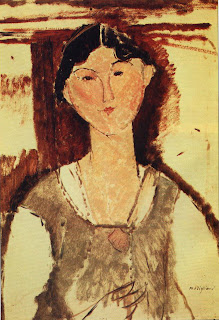
During
these early years in Paris, Modigliani was living an outmoded, 'decadent' image
of the artist. He affected an artistic style of dress, 'always in chestnut
corduroy, with a brilliant scarf around his neck and with a broad felt hat', as
a friend described him, and he despised Picasso's functional workman's
overalls. Modigliani's painting, too, was old fashioned, an uncertain synthesis
of the styles of Impressionism, Toulouse-Lautrec and Art Nouveau. These were
years of experiment and self-discovery. A memorial exhibition of Cezanne's work
was held in 1907 and soon Modigliani was imitating Cezanne's way of suggesting
form and space through colour. This new preoccupation with form led to his
first essays in sculpture. Between 1909 and the outbreak of war in 1914, he
produced few paintings. Working next door to the sculptor, Constantin Brancusi,
his attention focused on an ambitious and ultimately unrealized, sculptural project
of which the completed Caryatids (p.2409) formed only a small part.
Modigliani served his real apprenticeship
during these years. The demands he made on his weakened constitution were
evident to his mother on his return to Livorno in 1909. She indulged him and
bought him a new set of clothes. That he had changed was clear to his former
art school friends when he made another visit to Livorno in 1912. One observer
described him as follows: 'His head was shaven like an escaped convict... He
was wearing a miserable linen jacket and open shirt and his trousers were held
up by a string'.
He showed his companions photographs of his sculpture: they
said he was mad, and jokingly suggested that he dump them. Modigliani had never
felt so artistically isolated.
When
Beatrice Hastings, the South African journalist known to her Montparnasse neighbors’
as the 'English poetess', met Modigliani in 1914, it was not his art she, also,
considered it unexceptional that attracted her, but his appearance. He was 'the
pale ravishing villain' in corduroy. Beatrice gave Modigliani his first
sustained relationship. It was a gladiatorial affair with her able to match
Modi (as the artists named him) both in wilfulness and in her capacity for
drugs and drink.
The Impoverished Artist
 Modigliani
appears to have lived in conditions of extreme poverty soon after his arrival
in Paris. He occupied a succession of cheap rooms in Montmartre; then, having
moved south of the Seine in 1909, he found cheaper lodgings in Montparnasse.
His allowance from home was too small to buy art materials as well as the hashish
and absinthe on which he had become dependent. When he turned actively to
sculpture, he reputedly stole sleepers from the new Metro line nearby for wood
to carve; and many of the Caryatids were created from stone blocks removed from
construction sites by night, or lifted from the road surface.
Modigliani
appears to have lived in conditions of extreme poverty soon after his arrival
in Paris. He occupied a succession of cheap rooms in Montmartre; then, having
moved south of the Seine in 1909, he found cheaper lodgings in Montparnasse.
His allowance from home was too small to buy art materials as well as the hashish
and absinthe on which he had become dependent. When he turned actively to
sculpture, he reputedly stole sleepers from the new Metro line nearby for wood
to carve; and many of the Caryatids were created from stone blocks removed from
construction sites by night, or lifted from the road surface.
His
gradual drifting away from sculpture was compounded by the privations of the
First World Win He was often ill; his allowance from home ceased; he was
exploited by unscrupulous speculators. Many of his friends were at the Front
and the cafés were left to foreigners and invalids.
Yet,
paradoxically, his portraits achieved their familiar harmony and greatest
insight during the War years. Modigliani was encouraged by the dealer Paul
Guillaume, who bought all his works and rented a studio for him. Here, he
painted his famous series of nudes, though he seems to have rarely portrayed
his lovers in this way.
 Modigliani's
affair with Beatrice continued to be particularly stormy and violent. Their
arguments often deteriorated into physical fights. On one occasion he actually
threw Beatrice out of the window and, on another night, he rushed out of their
apartment, in a state of shock, having been bitten in the testicles. By 1915,
Modigliani had become increasingly dependent on drugs, while Beatrice, unable
to curb his excesses, and was now a virtual alcoholic. A year later, their
relationship was completely exhausted.
Modigliani's
affair with Beatrice continued to be particularly stormy and violent. Their
arguments often deteriorated into physical fights. On one occasion he actually
threw Beatrice out of the window and, on another night, he rushed out of their
apartment, in a state of shock, having been bitten in the testicles. By 1915,
Modigliani had become increasingly dependent on drugs, while Beatrice, unable
to curb his excesses, and was now a virtual alcoholic. A year later, their
relationship was completely exhausted.
In July
1917, Modigliani met Jeanne Hebuteme, a talented 19-year-old student at the
Academie Colarossi. He painted her portrait more than any other, and she bore
him a daughter, Jeanne. Her relationship with the artist was as stormy as
Beatrice's had been: stories of her ill-treatment in public places by
Modigliani are numerous. Unlike the poetess, however, Jeanne was timid, devoted
and suffered his infidelities.
Success
remained elusive in Modigliani's last years, although a market was cautiously
growing, encouraged by Leopold Zborowski who had succeeded Guillaume as Modi's
dealer in 1916 and who hawked canvases round Paris by foot on occasions to
interest collectors. Indeed, it was not easy to see Modigliani work for he
took part in few exhibitions.
exhibitions.
A SENSATIONAL SHOW
In
December 1917, his first one-man show was staged at the Berthe Weill gallery.
Modigliani had, by that time, received scant notice from the press: even the
seven sculpted heads included in the Salon d'Automne of 1912, passed largely
unnoticed. Zborowski was therefore keen to attract visitors and put several
nudes in the window, which unfortunately faced a police station. Equipped with
special powers in wartime, the police objected to the 'obscene' display and
closed the exhibition on its opening day.
 Zborowski was a Polish poet sympathetic to the
'peintres maudits'. He could afford to give Modi a small allowance although he
sold little; and to organize a trip for his artists to the South of France in
April 1918. Here Modigliani rediscovered his admiration for Cezanne, and also
painted his first landscape, as far as we know, since his student days in
Italy. He was accompanied to Cagnes-sur-mer by his friend, the painter Soutine,
who produced several wild landscapes starkly at odds with his companion's
tautly composed images. Towards the end of his life, Modigliani became more
superstitious when working, refusing to allow his studio to be cleaned or
disturbed as if this might threaten his fragile talent. This uncertainty was
probably provoked by his lack of success: financial well-being meant little to
him, but self-respect was essential.
Zborowski was a Polish poet sympathetic to the
'peintres maudits'. He could afford to give Modi a small allowance although he
sold little; and to organize a trip for his artists to the South of France in
April 1918. Here Modigliani rediscovered his admiration for Cezanne, and also
painted his first landscape, as far as we know, since his student days in
Italy. He was accompanied to Cagnes-sur-mer by his friend, the painter Soutine,
who produced several wild landscapes starkly at odds with his companion's
tautly composed images. Towards the end of his life, Modigliani became more
superstitious when working, refusing to allow his studio to be cleaned or
disturbed as if this might threaten his fragile talent. This uncertainty was
probably provoked by his lack of success: financial well-being meant little to
him, but self-respect was essential.
Modigliani
contracted pneumonia in the bitterly cold January of 1920. After drinking all
night in the local bars, always ending up at La Rosemonde, he would roll out into
the icy air of the early hours in just his shirt sleeves.
Contemporaries
described him on these occasions as 'very drunk, abusive and terribly
emaciated'. A few days before his death, he collapsed in the studio he shared
with Jeanne, and the terrified young girl sat watching him dying, without
thinking of sending for a doctor. On January 24 he died of tubercular
meningitis. He was 35. Jeanne's tragedy is inextricably linked with
Modigliani's. Several months pregnant with his second child, she threw herself
from an upstairs window at her home soon after his death. Five years later, her
body was moved from the bleak cemetery near Bandeaux, and she was buried beside
Modigliani at Pere Lachaise.
Writer-Marshall Cavendish
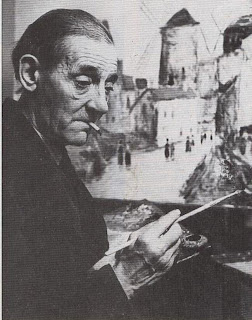
 Modigliani
appears to have lived in conditions of extreme poverty soon after his arrival
in Paris. He occupied a succession of cheap rooms in Montmartre; then, having
moved south of the Seine in 1909, he found cheaper lodgings in Montparnasse.
His allowance from home was too small to buy art materials as well as the hashish
and absinthe on which he had become dependent. When he turned actively to
sculpture, he reputedly stole sleepers from the new Metro line nearby for wood
to carve; and many of the Caryatids were created from stone blocks removed from
construction sites by night, or lifted from the road surface.
Modigliani
appears to have lived in conditions of extreme poverty soon after his arrival
in Paris. He occupied a succession of cheap rooms in Montmartre; then, having
moved south of the Seine in 1909, he found cheaper lodgings in Montparnasse.
His allowance from home was too small to buy art materials as well as the hashish
and absinthe on which he had become dependent. When he turned actively to
sculpture, he reputedly stole sleepers from the new Metro line nearby for wood
to carve; and many of the Caryatids were created from stone blocks removed from
construction sites by night, or lifted from the road surface. Modigliani's
affair with Beatrice continued to be particularly stormy and violent. Their
arguments often deteriorated into physical fights. On one occasion he actually
threw Beatrice out of the window and, on another night, he rushed out of their
apartment, in a state of shock, having been bitten in the testicles. By 1915,
Modigliani had become increasingly dependent on drugs, while Beatrice, unable
to curb his excesses, and was now a virtual alcoholic. A year later, their
relationship was completely exhausted.
Modigliani's
affair with Beatrice continued to be particularly stormy and violent. Their
arguments often deteriorated into physical fights. On one occasion he actually
threw Beatrice out of the window and, on another night, he rushed out of their
apartment, in a state of shock, having been bitten in the testicles. By 1915,
Modigliani had become increasingly dependent on drugs, while Beatrice, unable
to curb his excesses, and was now a virtual alcoholic. A year later, their
relationship was completely exhausted. Zborowski was a Polish poet sympathetic to the
'peintres maudits'. He could afford to give Modi a small allowance although he
sold little; and to organize a trip for his artists to the South of France in
April 1918. Here Modigliani rediscovered his admiration for Cezanne, and also
painted his first landscape, as far as we know, since his student days in
Italy. He was accompanied to Cagnes-sur-mer by his friend, the painter Soutine,
who produced several wild landscapes starkly at odds with his companion's
tautly composed images. Towards the end of his life, Modigliani became more
superstitious when working, refusing to allow his studio to be cleaned or
disturbed as if this might threaten his fragile talent. This uncertainty was
probably provoked by his lack of success: financial well-being meant little to
him, but self-respect was essential.
Zborowski was a Polish poet sympathetic to the
'peintres maudits'. He could afford to give Modi a small allowance although he
sold little; and to organize a trip for his artists to the South of France in
April 1918. Here Modigliani rediscovered his admiration for Cezanne, and also
painted his first landscape, as far as we know, since his student days in
Italy. He was accompanied to Cagnes-sur-mer by his friend, the painter Soutine,
who produced several wild landscapes starkly at odds with his companion's
tautly composed images. Towards the end of his life, Modigliani became more
superstitious when working, refusing to allow his studio to be cleaned or
disturbed as if this might threaten his fragile talent. This uncertainty was
probably provoked by his lack of success: financial well-being meant little to
him, but self-respect was essential. 


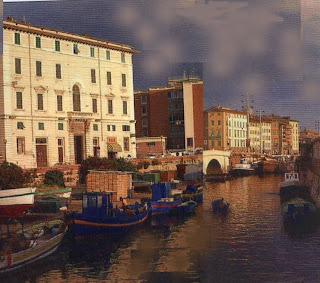
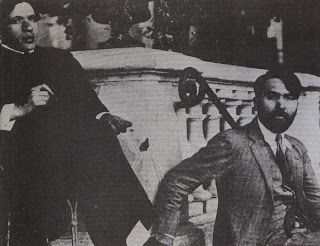

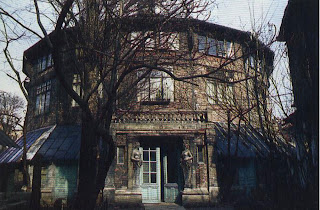










0 Response to "The Amedeo modigliani life"
Post a Comment